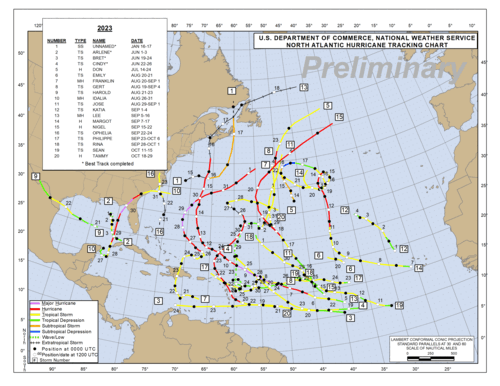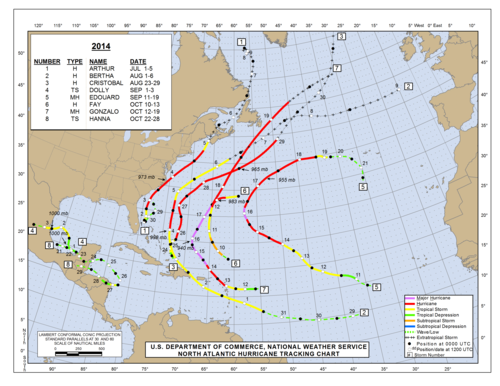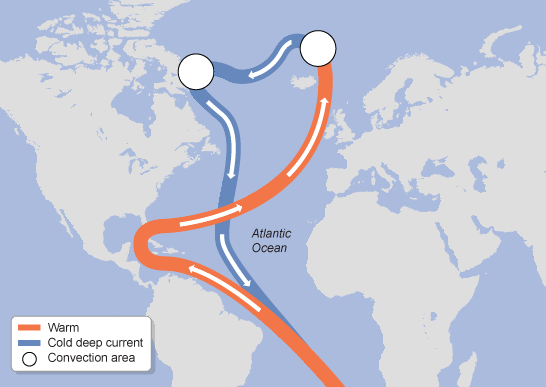Subtropical Storm Alex upgraded to hurricane
Source: ABC
The National Hurricane Center has upgraded a storm brewing in the Atlantic Ocean to hurricane status, a rarity for January. Hurricane Alex is located 490 miles (about 790 kilometers) south of Portugal's Azores islands, parts of which are under a hurricane warning.
Subtropical Storm Alex has formed in the eastern Atlantic, the first storm to form in that ocean in January in 38 years, the National Hurricane Center said Wednesday.
Alex is the first named storm of 2016, though the Atlantic hurricane season doesn't officially begin until June 1.
It is the first storm to form in the Atlantic in January since 1978 and is just the fourth known storm to form in the month since records began in 1851.
Read more: http://www.abc17news.com/national-news/rare-january-subtropical-storm-forms-in-atlantic/37419266

deathrind
(1,786 posts)Tornadoes and flooding in December, Hurricanes in January...seems to me that something about the climate is...changing.
Cassiopeia
(2,603 posts)I hope I'm wrong.
Roland99
(53,342 posts)happyslug
(14,779 posts)Last edited Thu Jan 14, 2016, 06:31 PM - Edit history (5)

http://www.nhc.noaa.gov/data/tcr/

http://www.nhc.noaa.gov/data/tcr/index.php?season=2014&basin=atl
Most of this is do to the prevailing currents in the Atlantic:

http://www.eoearth.org/view/article/150448/
http://www.esa.int/images/Thermohaline_large,0.jpg
http://www.esa.int/images/Gulf-Stream_large,0.jpg
http://www.esa.int/images/Gulf-Stream_large,0.jpg
http://www.esa.int/SPECIALS/Eduspace_Weather_EN/SEM1HYK1YHH_1.html
But could reflect El Nino, as it 2010 (Blue is cold currents, they run deep in the ocean and have little affect on Hurricanes, Red are warm currents, they run on the surface AND affect Hurricanes).

http://wakeup2010.blogspot.com/2010/09/north-atlantic-current-gone.html
Thus this storm is going AGAINST the Prevailing currents in that part of the Atlantic, UNLESS the Jet Stream has been shifted north in the Pacific do to El Nino and as a result has had to shift SOUTH over Eastern North America. That would also explain the recent cold snap over the Northern Eastern and Central US.

http://squall.sfsu.edu/crws/jetstream.html
But the jet stream in the Pacific is hitting California right now:

Do remember, each pole has TWO Jet Streams, the stronger one is the one closer to the Pole (Referred to a "Polar Jets"
As to California the it appears to being hit by a Polar Jet instead of a sub Polar Jet, which means any moisture California is getting is from further north in the Pacific then is normal.
https://en.wikipedia.org/wiki/Jet_stream
Do remember these Jets interact, merge then break up again all through the year, thus the effect varies. On the map, it looks like the sub tropical jet starts in Mali and the Sudan flows over India and China, but became the Polar Jet as it enters California, breaks up over the Rockies, but reform over the North Dakota, Saskatchewan Border and flows to Europe where it misses Russia by heading south to break up over Turkey and the Caspian Sea. A different sub tropical jet forms over the Pacific flows over Mexico then dies in the Atlantic.
Thus the two jets join up, breaks up, and reform to make a real mess of the weather.
hobbit709
(41,694 posts)phantom power
(25,966 posts)Hortensis
(58,785 posts)where we get fewer hurricanes a lot better. At least this one looks like it's going to commit suicide instead of taking a winter cruise to the Gulf of Mexico like a sensible one would.
Thanks for the heads up, MowCow. My hurricane "radar" was turned off.
happyslug
(14,779 posts)Two days ago it was reported the first Hurricane in the Western Pacific:
http://news.discovery.com/earth/weather-extreme-events/a-hurricane-in-january-you-can-thank-el-nino-160112.htm
http://ww2010.atmos.uiuc.edu/(Gh)/guides/mtr/hurr/enso.rxml
But that rule is based on that almost all of the El Ninos we have had have been off the coast of South America. Such El Ninos cause wind sheer over the Caribbean that forestalls winds gathering up into a hurricane.
The problem is this is a International Date Line El Nino, one of just two to have occurred. Instead of going along the West Coast of South American and then Central America, this El Nino is going north around the International Date Line, Thousands of miles to the West of where traditional El Ninos occuir.
http://phys.org/news/2015-12-el-nino-winter-average-precipitation.html
http://www.livescience.com/51024-predicting-el-nino-devastation-weeks-in-advance.html
http://www.niwa.co.nz/news/el-ni%C3%B1o-expected-to-produce-severe-tropical-storms-in-the-southwest-pacific
Thus we have a problem. Dateline El Ninos appear to have almost no affect on North America or the Caribbean sea, unlike South American El Ninos that produce more rain from California to Georgia but a decrease in Hurricanes in the Caribbean and Western Atlantic. One side note, we have seen so few Date line El Nino that the true affect is more an educated guess then a prediction, just a comment on the above and what I am saying.
This International Date Line El Nino may be powerful enough to force warm water further to the north then happens in past El Ninos, thus no additional rain for California and the Southwest, but increase snow for the Great Plains to the Atlantic (and also NO snow in the Pacific Northwest). El Nino does the above by forcing the Jet Steam North into the Arctic and taking any water in the air with it. The Jet Stream then swing south from the Northern Great Plans to the Atlantic bring with in massive snow falls (More between the Rockies and the Appalachians then on the other side of each, through you will see winter storms come up along the Gulf Stream in winter, dumping snow on the East Coast).
My prediction? More rain for California and the Southwest, but no where near what a normal El Nino would bring (i.e the drought continues). No affect on the Hurricane season, i.e more hurricanes then normal (Remember the Norm for an El Nino year is a DROP in the number of Hurricanes). In the North, between the mountains and North of the Ohio River and the Mason-Dixon line, we will get hit and hit hard by cold weather and snow storms, but the East Coast will see less then normal snowfall.
Remember winter 2009 to 2010? This will follow that pattern, but more severe and everthing further to the north.
Hortensis
(58,785 posts)Weather is so complex that despite a physical geography class long ago I have trouble remembering what affects what, but I'll never forget that 7 of our last 9 years in California were during severe drought. To this day water just left running even briefly bothers me terribly. PTSD. ![]()
My sister's in the Sierra Nevada among all those endangered trees and had been so hoping, at one time, for a good snowfall this year.
Surreal... This would be a fascinating time to be a climatologist. I'm going to push the idea at our science-oriented grandson. Seriously, although right now it's still dinosaurs or being a computer hacker.
happyslug
(14,779 posts)The more I read about this El Nino the more I believe the effects will be different from any other El Nino we have had. Most El Ninos, going along the South America Coast, rarely go further north then the Galapagos islands which are near the equator. Strong El Ninos hit Central America, but those were RARE. Dateline El Ninos are NOT reported prior to the 1990s, thus HOW they actually work is unknown, unlike South America El Ninos that we have reports on the effects since the late 1800s (Fishermen of South American gave the phenomena its name, because they first reported it to each other for it affected where they could find fish, thus we have records dating to the time period where most people in South American could read and write).
Side note: Most people did not learn to read and write prior to the 1830s. Pulp paper was invented in 1801, and slowly spread around the globe. Pulp paper permitted what we call newspapers to come into existence. Pulp fiction only came into use with Pulp paper. Pulp paper is CHEAP paper, unlike its predecessor in paper, linen paper. Linen paper is made from linen, i.e. cloth, T-Shirts are cheap and today made from much cheaper Cotton rather then linen, but it is a good way to look at the cost of reading and writing. Pulp paper is cheap, most people have a good idea of what pulp paper costs are. Linen paper is like using New T-shirts to print on and sell as a paper or book. Is it doable? yes, but can most people afford such books? The Answer is NO. Do you keep important records on such paper? Yes, but do you use it as scrap paper? No (unless it is truly scrap i.e. to be thrown away). Do you write in them? No, for once you read it, you may want to sell it and sell it at a good price. A good example of this when George Washington wanted his men to know the contents of Paine's "Common Sense". Washington has the officers of his army read it to their men for most of the enlisted ranks could NOT read or write. This is retain in many churches, for they developed their mass during that same time period, i.e. parts of the books in the bible are read to the people attending the mass, otherwise they never know the bible for they could NOT afford to buy one and if they did could not read it.
With Pulp paper, the price of paper dropped like a rock. Poor people could actually afford to buy books. Families could have more then one book (Most families in the US had a bible prior to the 1800s, for someone in the household, or someone outside who could read and write, could write down dates of births, deaths, marriages and other important dates for the family). You could actually USE the ability to read and write if you did NOT have any money. Thus, starting with Prussia, universal education became the norm in Europe and after 1830 in the US outside of the American South (The American South, as a general rule, did not get Public Schools till reconstruction, The "Gray Ghost" of Civil War fame, John Mosby said if the South had Public Education before the Civil War, the South would never have succeeded).
Students of the US Civil War give the fact that almost all of the Soldiers of the North could read and write do to the adoption of Public Education in the North starting in the 1830s. In the South up to a third (and some reports say half or more) of southern soldiers could NOT read or write,. This was a tremendous advantage to the North, they could issue written orders any all of their soldiers and such orders would be carried out. In the South, such orders had to be READ to the unit as a whole, which slowed down conveying those orders to all of the people in a unit. The subsequent Prussian defeat of Austria 1866) and France (1871) confirmed the military advantages of having an army that could read and write (All three nations had long accepted universal education but it was the most advanced in Prussia).
Thus by the 1870s getting everyone to read and write became the norm throughout the world. Sooner or later you would have to deal with Prussia or the US and with their Armies able to read and write you had to match them or face defeat. Some countries took a little longer then others (One of the advantages the Communists had in China, Vietnam and Cuba was they insisted on universal education even while they were fighting against the government they would later replace. Thus education of the young occurred even as they were fighting), but as a whole universal education became the norm.
This is a long way to get back to El Nino, but I will go back to El Nino. We started to see reports of El Nino in the 1880s, why? the Fishermen off the coasts of South American were the results of some of the first effort at universal education in South America. By the 1880s most such fisherman could read and write and report on the condition they faced in the ocean and make such reports in writing. Such reports could be gathered and kept and were later used to determine when El Ninos from the 1880s onward occurred. Prior to the 1880s, most if not all of the Fisherman off the West Coast of South America could not read and write and thus did not leave any written reports that we can research today.
It is interesting how something like making sure people could read and write AND having something even poor people could use the ability to read and write on (Pulp paper to write notes down on) affects us decades later. Pulp paper is one of the greatest inventions in history, but is little thought of given its cheap price. Without pulp paper, universal education is almost useless for without pulp paper what would you be reading or writing on prior to computers? Even universal education was marginal prior to Pulp Paper (Now, prior to the 1800s most people could recognize writing and even some words, but that was about it for that is all they needed, books were expensive and this cheaper to PAY someone read it to a large group of people then for each member of the group to buy a book).
In many ways our knowledge of El Nino going back to the 1880s is an example of "Data Mining" but you can only "Date Mine" if there is data to collect, and you can not have that independent of Pulp Paper when it comes to things poor people saw.
Pulp paper is up there as one of the top inventions in history along with Fire, the Wheel, the sewing needle, ball bearings, gunpowder, the percussion cap and transistor (Notice most of these are cheap everyday items we take for granted, but think about not having heat, carrying heavy loads on your back, not in a cart or car, clothes that actually confirm to the body, firearms and computers, these like pulp paper are everyday things but without them a lot of other things are just NOT possible).
Just a comment on why we have records of El Nino only from the 1880s (and a Comment why we do have such information in the first place).
Hortensis
(58,785 posts)Jefferson and others felt education was critical to maintaining a free society, but I didn't connect the delay in really getting that wheel turning with the availability of affordable paper.
I see you were talking about dateline El Ninos before. I love California and all its richness and variety and hate the destruction of so much that is wonderful. I was just reading that roughly a billion trees in the Sierra Nevada are believed in danger. It's very beautiful up there. A propos of nothing, the last time I drove up to visit my sister, a duck that saw me coming staked out the gravel road going by his pond and wouldn't let me drive through until I got out and threatened to brutalize him.
In Georgia the most likely scenario is that our mixed oak-hickory woods will be replaced by the piney woods farther south on the coastal plain. We don't expect to see that complete, but we do expect to need to somehow be able to budget for continual tree removal as the less resilient species keep dying. We have only 4 acres, but we've already had to take down a few large dying hardwoods, in addition to a large stand of dead and dying pines. Among an extravagant mixture of tree species, I'm selecting mostly for hickories, some white oaks, and redbuds among the seedlings as they're reportedly better able to take heat and drought than many others, like red oaks, maples and dogwoods. Some others, though, I choose because I love them too, especially if they're where they will get some shade, but with hope and trepidation. The large black gum shading our entry terrace is beautiful but drops its leaves in August these days. Sigh...
yellowcanine
(35,699 posts)GummyBearz
(2,931 posts)
Odin2005
(53,521 posts)Nihil
(13,508 posts)... as even though the strength of Alex will deteriorate in the North, the
wave action will still be effective ...